Shopify Advanced Plan 2024: Pricing, Features, and comparisons
Are you tired of hitting roadblocks as your online business grows? Imagine having the tools to effortlessly scale your store, handle a flood of orders, and unlock your full potential.
The Shopify Advanced Plan is the answer you've been searching for – a comprehensive solution designed for high-volume businesses ready to dominate.
Keep reading to uncover the full potential of "Shopify Advanced Plan", explore its pricing, features, and how it compares to other options in 2024.
What is the Shopify Advanced Plan?
The Advanced Shopify plan is a Shopify pricing plan suited for large businesses. It includes all the features of the Basic Shopify plan and the Shopify plan, and offers the lowest credit card rates and transaction fees.
How much Does the Shopify Advanced Plan cost?
Subscription Fees
Payment Options
The Shopify Advanced Plan offers two payment options:
- Monthly: USD 399 per month.
- Yearly: USD 299 per month if you pay for the year upfront.
By choosing the annual option, you save $1200 annually - that's $100 each month!

Free Trial and Special Offer
- Shopify Free Trial: Enjoy a 3-day free trial before committing.
- Special Offer for New Subscribers: Pay just $1 for the first month instead of the usual $39.
By combining the free trial and the $1 deal, you save an additional $39 in the first month.
Exclusive Offer: Get Shopify 33 days for just $1 + The Online Store Starter Kit
Start your 3-day free trial, and enjoy your first month of Shopify for 1$ plus the premium package designed especially for new Shopify merchants!
Expert Recommendation
I strongly recommend opting for the yearly plan. While it requires an upfront investment, the lower monthly cost frees up funds for marketing, inventory, and other growth initiatives.
Transaction Fees
The Advanced Shopify Plan offers the lowest transaction fees among Shopify's plans.
Here’s a detailed look.
Shopify Payments
Using Shopify Payments, Shopify’s built-in payment gateway, waves the transaction fees. However, you'll still have credit card processing fees, which vary depending on your pricing plan.
Credit card fees
The Advanced Plan charges a fee of 2.5% + 30c per online transaction and 2.4% + 10c per in-person transaction. This is lower than the transaction fees for the Basic and Standard plans.
External payment gateway
When using external payment gateways, the Advanced Plan incurs a transaction fee of 0.6%, which is significantly lower than the fees for the Basic and Shopify plans, which charge up to 2%
Note:
If you use an external payment gateway, you'll pay their fees in addition to Shopify's 0.6% transaction fee on the Advanced Shopify plan.
For instance, PayPal charges 2.99% + $0.49 per transaction, while American Express charges 3.4% to 3.9%. So, it’s best to check with your 3rd payment provider.
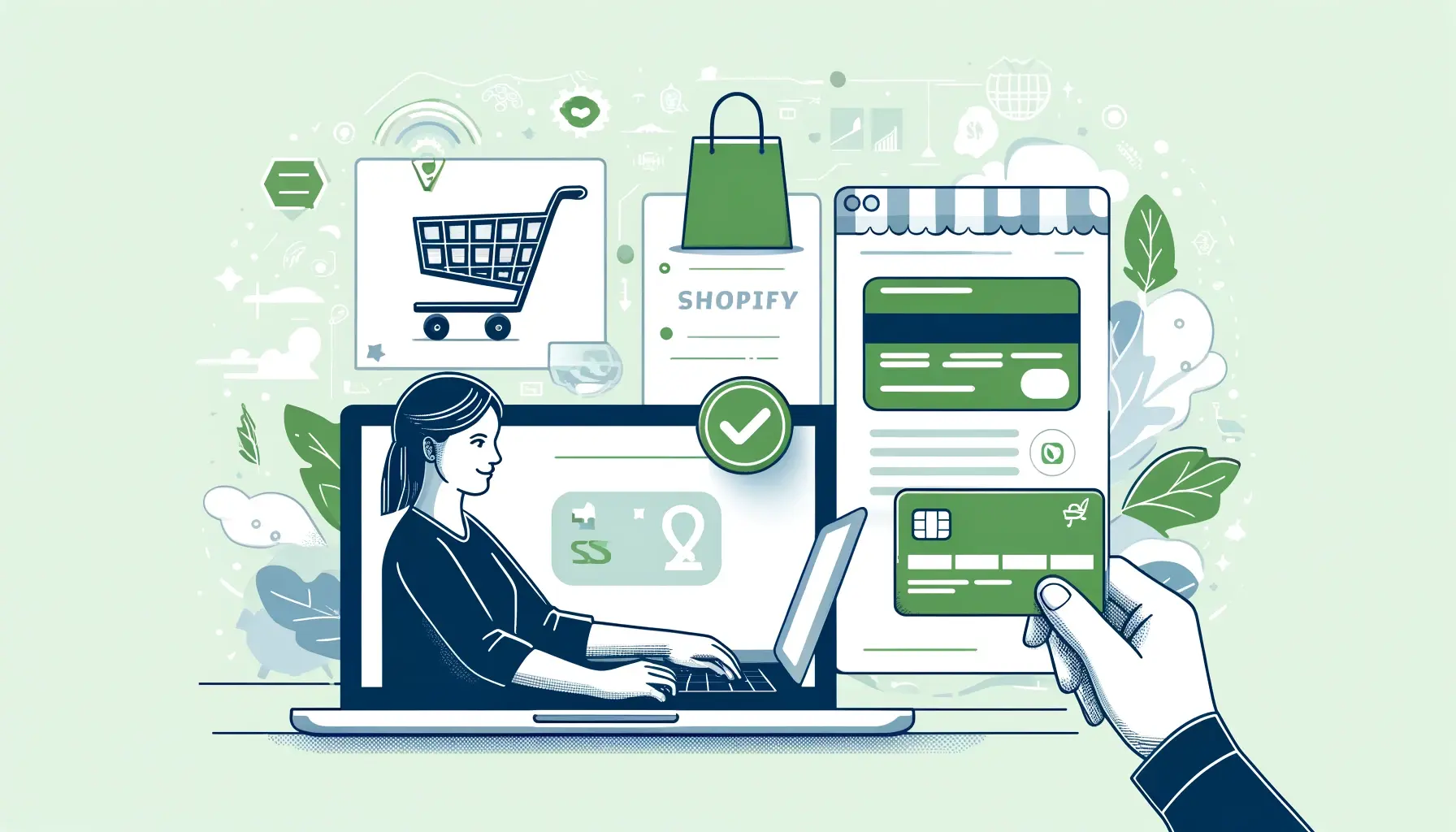
Shopify Advanced vs. Shopify: Transaction Fee Comparison
The Advanced plan offers lower transaction fees for both online and in-person sales. Let's clearly outline the potential savings compared to the lower-tier Shopify plan.
Online Sales Transaction Fees:
- Shopify Plan: 2.7% + $0.30; Third-party fee: 1%
- Shopify Advanced Plan: 2.5% + $0.30; Third-party Fee: 0.6%
⇒ 0.4% reduction
In-Person Sales Transaction Fees:
- Shopify Plan: 2.5% + $0.10
- Shopify Advanced Plan: 2.4% + $0.10
⇒ 0.1% reduction
Now, consider the potential savings for three different monthly sales volumes: $10,000, $50,000, and $100,000.
Online Sales Savings Calculation
| Monthly Sales | Shopify Plan Fee | Advanced Plan Fee | Monthly Savings | Yearly Savings |
| $10,000 | $270 + $30 = $300 | $250 + $30 = $280 | $20 | $240 |
| $50,000 | $1,350 + $150 = $1,500 | $1,250 + $150 = $1,400 | $100 | $1,200 |
| $100,000 | $2,700 + $300 = $3,000 | $2,500 + $300 = $2,800 | $200 | $2,400 |
In-Person Sales Savings Calculation
| Monthly Sales | Shopify Plan Fee | Advanced Plan Fee | Monthly Savings | Yearly Savings |
| $10,000 | $250 + $10 = $260 | $240 + $10 = $250 | $10 | $120 |
| $50,000 | $1,250 + $50 = $1,300 | $1,200 + $50 = $1,250 | $50 | $600 |
| $100,000 | $2,500 + $100 = $2,600 | $2,400 + $100 = $2,500 | $100 | $1,200 |
Third-Party Provider Savings Calculation
For online transactions using third-party payment providers:
| Monthly Sales | Shopify Plan Fee (1%) | Advanced Plan Fee (0.6%) | Monthly Savings | Yearly Savings |
| $10,000 | $100 | $60 | $40 | $480 |
| $50,000 | $500 | $300 | $200 | $2,400 |
| $100,000 | $1,000 | $600 | $400 | $4,800 |
Verdict
I recommend considering an upgrade to the Shopify Advanced plan when your monthly sales volume reaches or exceeds $50,000. This plan reduces transaction fees significantly, especially with third-party payment providers.
Additional Costs
There are additional costs associated with the Advanced Shopify plan:
- Domain Purchase: Starts at $14 per year via Shopify or external registrars like Namecheap and GoDaddy.
- Email Hosting: No built-in email hosting; Shopify Email app is free for the first 10,000 emails, then $1 per 1,000 emails sent.
- Shopify Apps or third-party apps: Costs vary; the average app subscription is around $19 per month.
- Shopify Themes: Prices range from $0 to $350; free themes available.
- Shopify POS Pricing
- POS Lite: Free on Shopify Advanced Plan.
- POS Pro: $89 per store location.
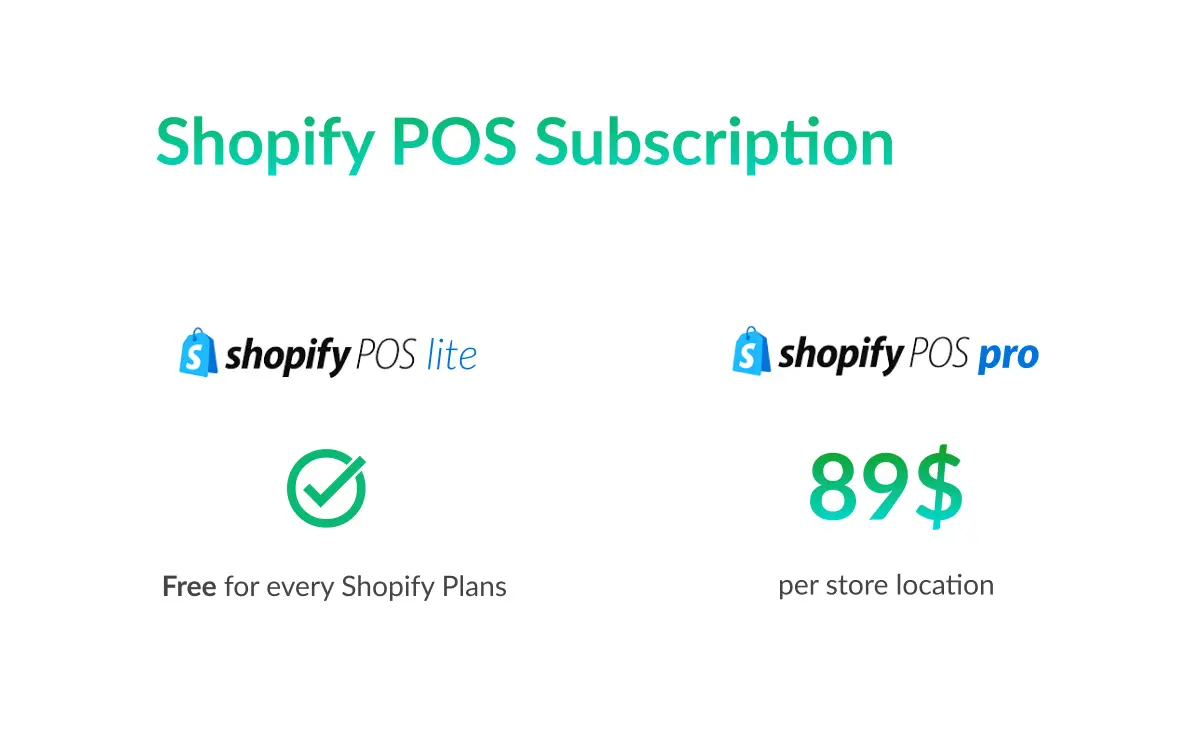
Shopify Advanced Plan Features Overview
Advanced Reporting
With the advanced reporting capabilities, you can access to:
- Custom Reports
- Analyze sales performance by channel, product category, or marketing campaign.
- Understand customer behavior across demographics and buying habits.
- Gain insights into inventory management, including stock levels, product popularity, and supplier performance.
- Detailed Analytics
- Customer Segmentation: Analyze customer behavior based on demographics, purchase history, and preferences.
- Marketing Attribution: Track the effectiveness of your marketing efforts across different channels (e.g., social media, email marketing, paid advertising). Identify which channels generate the highest return on investment (ROI) and optimize your marketing spend accordingly.
- Cohort Analysis: Compare the behavior of different customer groups acquired at various times.

In short, the Advanced Reporting feature is a game-changer for data-driven businesses. It's like having a magnifying glass that reveals the inner workings of your store. Instead of just seeing surface-level numbers, you'll uncover the "why" behind the "what."
For instance, a spike in sales might seem significant at first. Still, the Advanced Reporting feature can reveal if it's due to a successful marketing campaign, a seasonal trend, or simply a lucky coincidence.
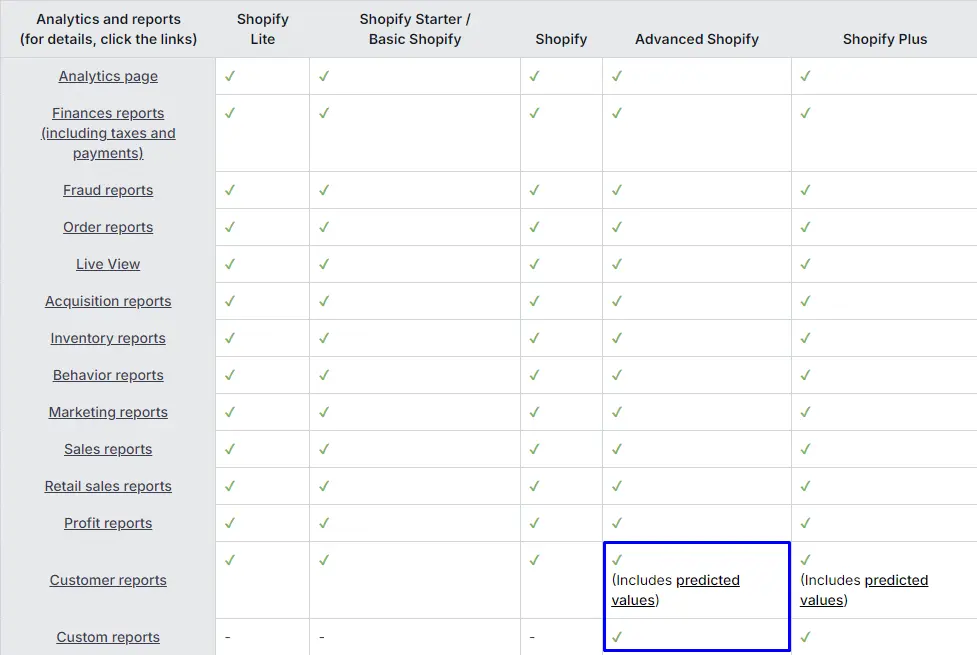
Carrier-Calculated Shipping
Carrier-calculated shipping lets businesses integrate directly with major shipping carriers like USPS, UPS, and FedEx. This feature automatically shows real-time shipping rates at checkout.
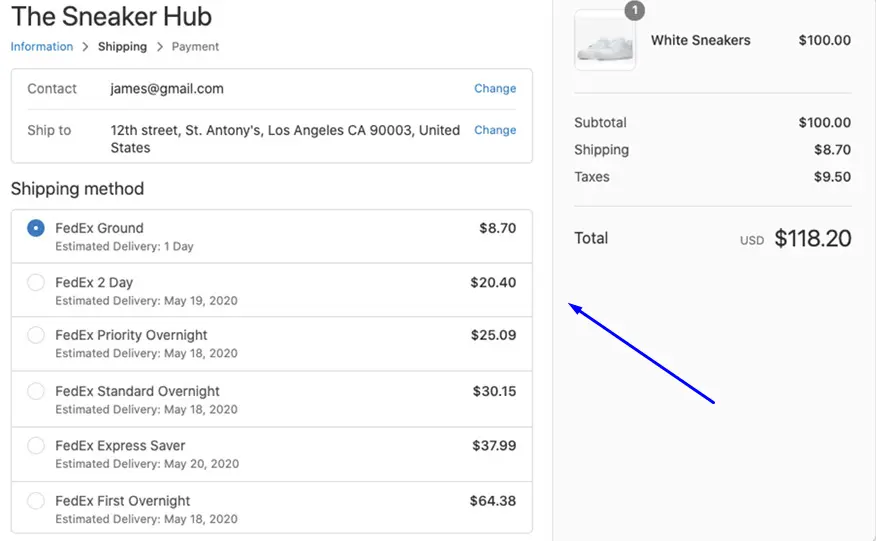
This means customers see dynamic rates based on their specific order, choosing the speed or cost that works best for them. You can even automate the selection, prioritizing speed or cost based on your preferences – this saves you time and ensures a smooth checkout experience for your customers.
It is available only on Shopify's Advanced Plan, unlike the lower Shopify pricing plans like the Shopify Basic Plan and the Shopify Plan. It provides:
- Accurate Shipping Costs: Shows real-time shipping costs during checkout. This reduces losses from undercharging for shipping.
- Multiple Carrier Options: Connects with various carriers. Customers can choose their preferred shipping option.
- Automatic Selection: Automatically picks the cheapest or fastest shipping method. This saves time and reduces manual work.
Shopify's Carrier-Calculated Shipping simplifies the shipping process and enhances the customer experience. That leads to higher satisfaction and potentially increases customer loyalty.
This feature particularly benefits businesses aiming to scale and maintain high customer service standards in their shipping operations.
Duties And Taxes Calculation
The Shopify Advanced plan features a built-in duties and tax calculator. It's a game-changer, especially when expanding your business globally.
Basically, through the Advanced plan, you can estimate and collect those unexpected fees upfront during checkout. This means fewer abandoned carts, as customers appreciate knowing the full cost upfront. Also, transparency in pricing helps build trust, as customers don’t encounter unexpected fees after making a purchase.

10x Faster Checkout capacity
The Shopify Advanced Plan's Checkout Capacity feature is a lifeline for businesses during high-traffic events like Black Friday or flash sales. It processes transactions up to 10 times faster than the Basic and Shopify plans, preventing site crashes and keeping customers happy.
Imagine this: a massive influx of eager shoppers flooding your store. Instead of crashing under pressure, your site seamlessly handles the traffic surge. Even better, Shopify's queue management system steps in if the traffic is exceptionally high. Customers are placed in a virtual line with precise wait times and updates, eliminating frustration and keeping them engaged.

Additional Staff Accounts
The Shopify Advanced lets you build a bigger team with up to 15 staff accounts. That's a major upgrade from the five allowed on the Shopify plan and none on the Basic plan.
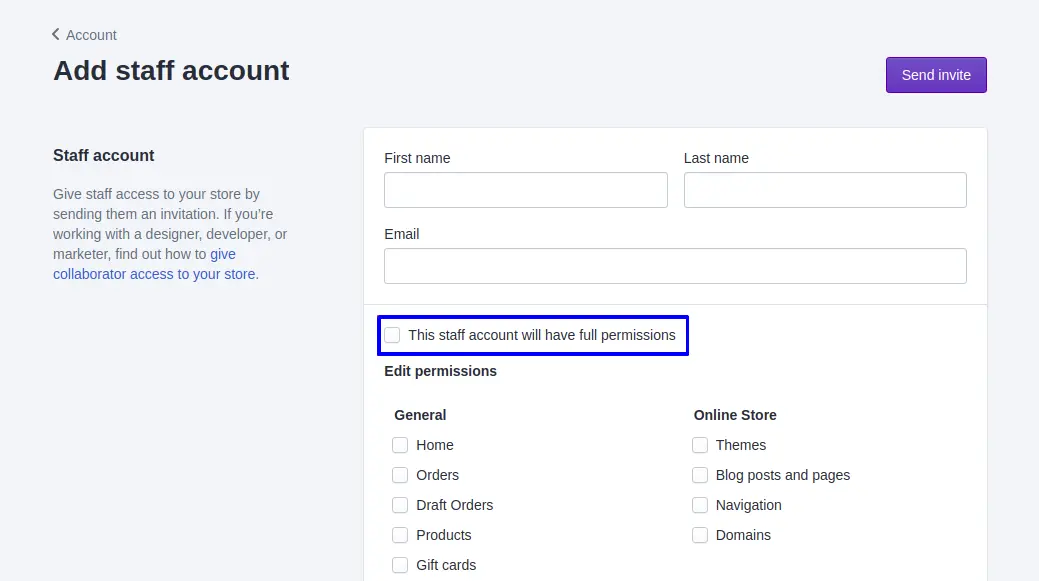
With more staff, you can delegate tasks effectively. You control who has access to what, ensuring each team member has the right permissions for their role. For instance, your inventory manager can focus on product management while your customer service team handles inquiries.
As your business grows, so can your team, ensuring you can meet rising demands without sacrificing efficiency or customer service
Localized Selling With Custom Markets
Shopify's Advanced Plan includes Shopify Markets, a cross-border management tool that helps businesses unlock global expansion opportunities. This tool allows businesses to manage international sales from one centralized hub, eliminating the need for separate stores for each region.
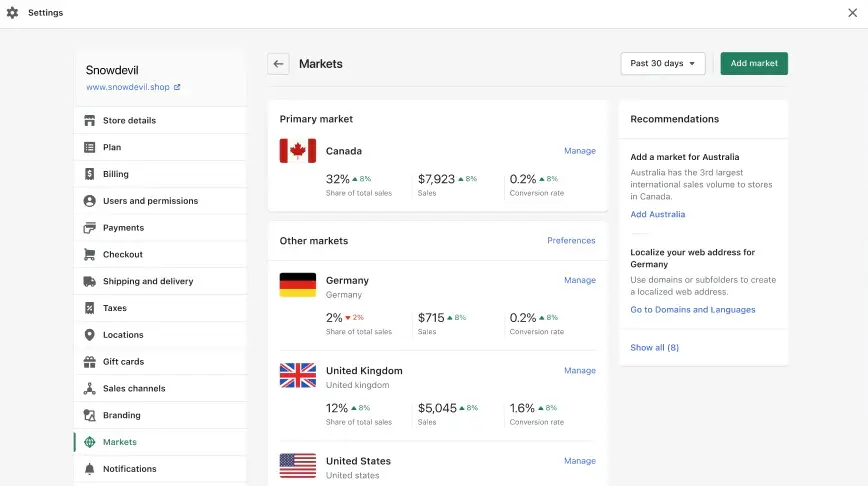
With Shopify Markets, businesses can customize their online stores for different regions. This includes adjusting product prices, content, and marketing strategies to suit local tastes and shopping habits.
This includes accommodating factors like:
- Currency: Display prices in the local currency for better transparency.
- Language: Deliver product descriptions and marketing messages in the preferred language of your target audience.
- Payment Methods: Offer popular payment options used in each region to streamline the checkout process.
- Taxes and Regulations: Ensure compliance with local tax regulations to avoid legal issues.
- Cultural Preferences: Adapt product offerings, marketing visuals, and overall brand messaging to resonate with local cultural norms.
Initially, you can target up to three markets without additional costs. Expanding beyond that is simple, with each additional active market costing $59 monthly. This flexible pricing structure allows businesses to scale at their own pace, entering new markets as they gain confidence in cross-border trade.
How to Set Up an Online Store with the Shopify Advanced Plan from Scratch
Here, we have documented all the steps you need to take to create and run an online store with the Shopify Advanced Plan.
Step 1: Creating a Shopify Account
- Visit the Shopify website and click on "Start free trial."
- Provide your email address, choose a password, and name your store.
- Answer questions to tailor Shopify's setup to your business needs.
You can skip all the questions and tailor the settings to your preferences later.

Step 2: Selecting a Plan
- Click on the “Select a Plan” button in the left-bottom corner of the screen.
- Click on “Select Advanced."
- Fill in your payment details.
- Click on the “Subscribe” button.

Step 3: Choosing a Theme
- Access the ‘Themes’ section under ‘Online Store’ in the Shopify admin.
- Use filters to select themes by industry or features.
- Preview themes on both desktop and mobile.
- Add and publish your chosen theme for immediate use.
- Consider hiring a designer for a custom look.
- Always use professional photography and videos for products.

Step 4: Adding Products
- Go to ‘Products,’ then click ‘Add product’ in the Shopify admin.
- Enter the product name and description, and upload high-quality images.
- Include essential details like price, tax status, and inventory.
- Use SEO-friendly product descriptions and titles.
- Click "Save."
- Use product management apps for bulk uploads.
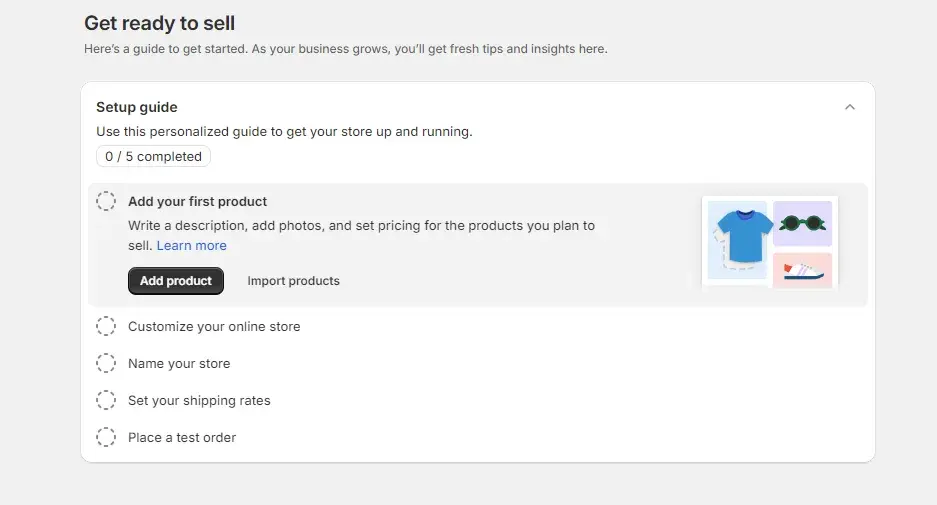
Step 5: Setting Up Collections
- Go to "Products."
- Click "Collections."
- Click "Create Collection."
- Enter a name and description.
- Add products to the collection.
- Click "Save."
- Use advanced product filtering for better customer experience.
Step 6: Adding Shopify Apps
- Navigate to the Shopify App Store via ‘Apps’ in your admin dashboard.
- Select apps that enhance functionality, like email marketing or SEO tools.
- Read reviews and integrate apps that meet your specific needs.
- Look for essential apps in categories like live chat support, CRM systems, etc.
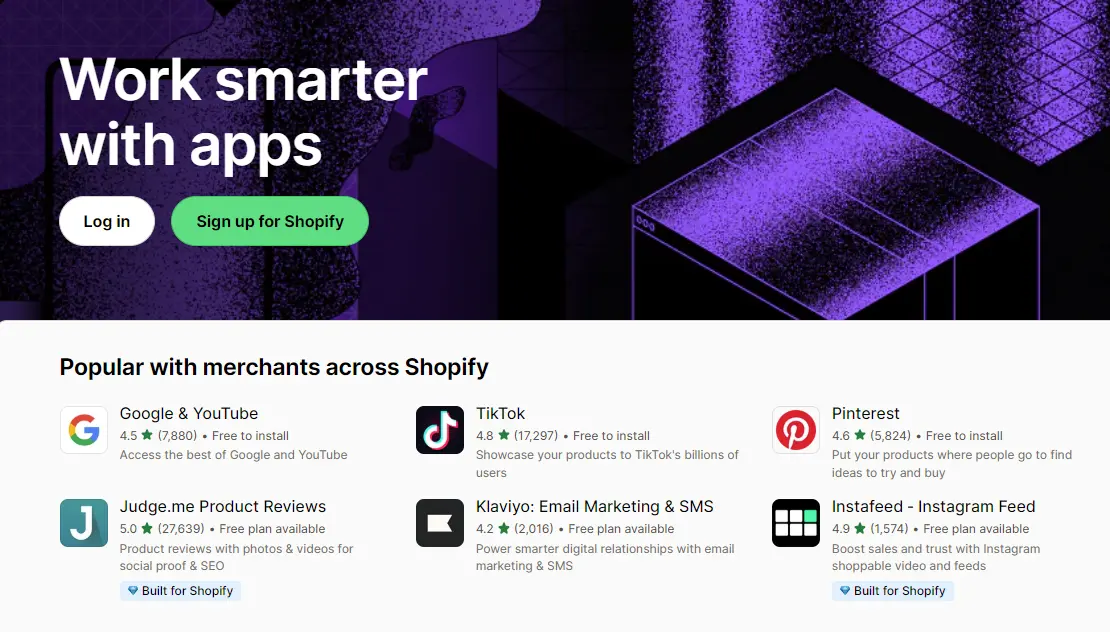
Step 7: Optimizing Search Engine Listings
- Edit the SEO settings for your products, pages, and posts.
- Write meta titles and descriptions incorporating relevant keywords.
- Add alt text to images to improve SEO and accessibility.
Step 8: Setting Up Payment Gateways
- Go to "Settings."
- Click "Payments."
- Choose a payment provider.
- Follow the prompts to set it up.
- Consider multiple payment options for customer convenience.
Step 9: Setting Up Taxes
- Go to "Settings."
- Click "Taxes and Duties."
- Configure tax settings based on your location.
- Consult with a tax professional for compliance in multiple regions.
Step 10: Reviewing and Previewing Your Progress
- Preview your store by clicking the ‘Eye’ icon next to the ‘Online Store’ button on your Shopify admin.
- Test a few transactions to ensure the checkout process is error-free.
- Check responsiveness and functionality on various devices.
Step 11: Unlocking Advanced Features
Advanced Reporting:
- Go to "Analytics."
- Click "Reports."
- Access detailed reports on sales, customers, and acquisition.
- Customize the reports based on your preferences.
Third-Party Calculated Shipping Rates:
- Go to "Settings."
- Click "Shipping and Delivery."
- Scroll to "Enable third-party calculated rates at checkout."
- Integrate with shipping carriers like FedEx or UPS.
- Add shipping zones and rates.
- Set up shipping profiles if needed.
Additional Considerations for Large Businesses
Scalability
- Monitor Performance: Regularly monitor your store’s performance.
- Upgrade Hosting: Upgrade your hosting plan if needed.
- Automation: Use apps to automate processes like inventory management and customer service.
- International Expansion: Plan for international expansion, including setting up multi-currency options and international shipping.
Customer Service
- Live Chat Support: Implement live chat support for real-time assistance.
- CRM Systems: Use a CRM system to manage customer relationships effectively.
- Dedicated Support Team: Consider hiring a dedicated customer service team.
Marketing Strategies
- SEO Optimization: Hire an SEO expert for better search engine rankings.
- Email Marketing: Use advanced email marketing tools and segmentation.
- Social Media Campaigns: Implement targeted social media campaigns.
- Influencer Marketing: Collaborate with influencers to reach a wider audience.
- PPC Campaigns: Use Pay-Per-Click advertising for more traffic.
Shopify Advanced Plan vs Shopify Plan: Which is For You?
When deciding on a Shopify plan, businesses should ask themselves these straightforward questions to determine the best fit:
- Monthly Sales: Are they consistently under or over $10,000? This helps determine if the Advanced Plan's lower transaction fees will save you money.
- Shipping Needs: Do you need basic shipping or advanced options like real-time carrier rates and international shipping?
- Reporting: Are simple reports sufficient, or do you require in-depth, customizable reports for more profound analysis?
- Staff Accounts: Will 5 staff accounts do, or do you need up to 15?
- International Sales: If yes, you'll need tools to manage pricing and taxes in different markets.
- Growth Plans: Are you expecting significant growth? The Advanced Plan offers features that support scaling businesses.
- Transaction Fees: Would the lower fees on the Advanced Plan significantly impact your profitability?
Here's a detailed table to help visualize the differences and decide which Shopify plan better suits your business needs:
| Aspects to Consider | Shopify Plan | Shopify Advanced |
| Sales Volume | Suitable for sales under $10,000/month | Best for sales over $10,000/month |
| Transaction Fees | Higher fees | Lower fees |
| Reporting and Analytics | Basic reporting tools | Advanced reporting tools with custom report creation |
| Staff Accounts | Up to 5 staff accounts | Up to 15 staff accounts |
| Shipping Solutions | No third-party calculated shipping rates | Third-party calculated shipping rates |
| International Commerce | Basic tools for minor international sales | Enhanced tools for multiple markets |
| Growth Trajectory | Stable, moderate growth | Rapid scaling and expansion |
To keep it short, from an expert's perspective, here’s how I suggest you should decide:
Choose Shopify Plan if:
- Your business is in the early stages or has stable, moderate sales that do not justify the need for complex functionalities.
- You are primarily serving a domestic market or have minimal international sales.
- You have a small team that requires backend access.
Choose Shopify Advanced if:
- Your business experiences or expects rapid sales growth, particularly more than $10,000 in monthly sales.
- You require sophisticated reporting to manage complex operations or multiple product lines.
- You need more comprehensive shipping options for a broad or international customer base.
- You are scaling up operations and your team size, needing more administrative control.

5 Tips for Maximizing Your Advanced Shopify Plan
Advanced Reporting:
- Weekly Reports: Create detailed sales reports to track top-selling products and make timely inventory adjustments.
- Monthly Reports: Analyze customer demographics to tailor marketing campaigns for specific audiences.
- Example: Offer targeted loyalty programs to high-value customer segments for increased retention.
Lower Transaction Fees:
- Track Savings: Document and reinvest your monthly savings in areas like product development or marketing.
- Example: Use savings to fund a targeted social media ad campaign to attract new customers.
Staff Accounts:
- Role-Based Access: Implement role-based access to ensure team members have the right tools and information while protecting sensitive data.
- Automation: Automate repetitive tasks to boost productivity and free up your team for more strategic work.
Global Expansion:
- Shopify Markets: Use Shopify Markets to tailor pricing strategies for different regions and increase international sales.
Real-Time Shipping:
- Regular Review: Analyze shipping data to identify cost-effective strategies and adjust as needed.
- Flexible Options: To meet customer needs, offer various shipping options at checkout, including standard and expedited delivery.
- Example: Consider free shipping thresholds or same-day delivery in select areas to boost customer satisfaction.
Advanced Shopify Plan: FAQs
What Is The Difference Between Basic Shopify And Advanced Shopify Plans?
The Advanced Shopify Plan offers all the features of Basic Shopify, plus:
- Lower credit card processing fees
- Advanced reporting with custom report building
- Third-party calculated shipping rates
- More staff accounts (15 vs. 0)
- Enhanced international selling tools
How Much Does the Advanced Shopify Plan Cost?
The Advanced Shopify plan costs $299 per month (billed annually) or $399 per month (billed monthly). New users can get their first month for $1 after 3-day Shopify free trial.
What Are The Different Shopify Plans?
Shopify offers several plans:
- Basic: For new businesses with basic features.
- Shopify: For growing businesses with more features.
- Advanced: For high-volume businesses with the lowest fees and most advanced features.
- Shopify Plus: A fully customizable enterprise solution for large businesses.
Is Shopify Plus The Same As The Advanced Shopify Plan?
No, Shopify Plus is not the same as the Advanced Shopify Plan. Shopify Plus offers more advanced features, higher levels of customization, dedicated support, and is designed for high-volume merchants and larger businesses.
Can You Downgrade from the Shopify Advanced Plan to a Lower Tier?
Yes, you can downgrade from the Shopify Advanced Plan to a lower tier. To make this change, contact Shopify Plus Support. It’s important to note that downgrading may result in the loss of certain advanced features and could lead to higher transaction fees.
Final Thoughts
The Shopify Advanced Plan is the key to success for growing businesses. We hope that this review helps you understand the plan's capabilities and how it can fit into your overall business strategy.
Related articles:





